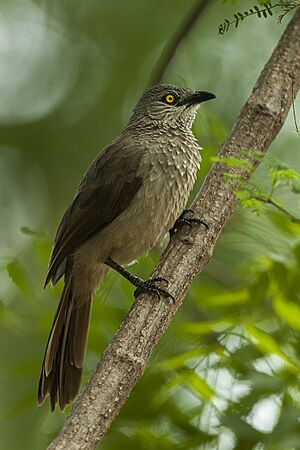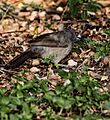Brown babbler facts for kids
Quick facts for kids Brown babbler |
|
|---|---|
 |
|
| Brown babbler in Baringo, Kenya | |
| Conservation status | |
| Scientific classification | |
| Genus: |
Turdoides
|
| Species: |
plebejus
|
The brown babbler (Turdoides plebejus) is a type of bird that belongs to the family Leiothrichidae. These birds mostly live in West Africa, but you can find them all the way from the Gambia to Kenya. They are quite common in the areas where they live. Some people also call this bird the Sudan babbler.
Contents
About the Brown Babbler
The brown babbler was first described in 1828 by a scientist named Philipp Jakob Cretzschmar. He found a specimen, which is a sample of the animal, in a place called Kordofan Province in Sudan. At first, he thought it was a type of bulbul bird.
This bird is closely related to other babblers. These include the white-headed babbler, which lives in eastern Sudan, Ethiopia, and Eritrea. It's also related to the arrow-marked babbler, found in central and southern Africa.
What Does It Look Like?
The brown babbler is a medium-sized bird. It usually measures about 22 to 25 centimeters (8.7 to 9.8 inches) long. It weighs around 52 to 80 grams (1.8 to 2.8 ounces).
Its feathers are mostly grey-brown. It has a throat and chest that are streaked with white. Its head looks a bit scaly. The wings are a bronze-brown color. Its beak is black, and its legs are dark or slaty black. The eyes of an adult brown babbler are yellow.
Both male and female brown babblers look alike. Young birds look similar to adults, but their feathers are plainer and browner. Also, young birds have brown eyes instead of yellow ones.
Where Do They Live?
Brown babblers live in a wide strip of land called the Sahel. This area is located between the Sahara Desert and the tropical forests of Western Africa. You can find them from southern Mauritania, Senegal, and the Gambia, all the way to southern Sudan, Uganda, and western Kenya.
These birds prefer open savanna areas and wooded grasslands. They also live near rivers in drier places. You can often spot them in areas changed by humans, like farms, parks, and gardens. Since they are common and can live well near people, they are not considered to be in danger of extinction.
Brown babblers usually stay in one place and do not migrate long distances. However, they might move around a bit depending on the rainy seasons. For example, in central Burkina Faso, they are seen more often during the rainy season.
How Do They Behave?
Brown babblers eat a variety of things. Their diet includes many insects like ants, beetles, termites, and praying mantises. They also eat other small creatures without backbones, as well as berries and fruits. Sometimes, if they find it, they will even eat carrion, which is the meat of dead animals.
They usually look for food on the ground. They often do this in groups, which are like family parties. These groups can have up to 14 individual birds.
Images for kids




